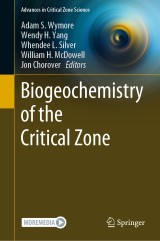Details

Biogeochemistry of the Critical Zone
Advances in Critical Zone Science
|
149,79 € |
|
| Verlag: | Springer |
| Format: | |
| Veröffentl.: | 16.05.2022 |
| ISBN/EAN: | 9783030959210 |
| Sprache: | englisch |
| Anzahl Seiten: | 202 |
Dieses eBook enthält ein Wasserzeichen.
Beschreibungen
<p>This book highlights recent advances in the discipline of biogeochemistry that have directly resulted from the development of critical zone (CZ) science. The earth's critical zone (CZ) is defined from the weathering front and lowest extent of freely circulating groundwater up through the regolith and to the top of the vegetative canopy. The structure and function of the CZ is shaped through tectonic, lithologic, hydrologic, climatic, and biological processes and is the result of processes occurring at multiple time scales from eons to seconds. The CZ is an open system in which energy and matter are both transported and transformed. Critical zone science provides a novel and unifying framework to consider those coupled interactions that control biogeochemical cycles and fluxes of energy and matter that are critical to sustaining a habitable planet. </p>Biogeochemical processes are at the heart of energy and matter fluxes through ecosystems and watersheds. They control thequantity and quality of carbon and nutrients available for living organisms, control the retention and export of nutrients affecting water quality and soil fertility, and influence the ability for ecosystems to sequester carbon. As the term implies, biogeochemical cycles, and the rates at which they occur, result from the interaction of biological, chemical, and physical processes. However, finding a unifying framework by which to study these interactions is challenging, and the different components of bio-geo-chemistry are often studied in isolation. <p></p><p>The authors provide both reviews and original research contributions with the requirement that the chapters incorporate a CZ framework to test biogeochemical theory and/or develop new and robust predictive models regarding elemental cycles. The book demonstrates how the CZ framework provides novel insights into biogeochemistry.</p><p></p><p></p>
An Introduction to Biogeochemistry of the Critical Zone.- Hot Spots and Hot Moments in the Critical Zone: Identification of and Incorporation into Reactive Transport Models.- Constraints of Climate and Age on Soil Development in Hawai‘i.- Biofilms in the Critical Zone: Distribution and Mediation of Processe.- Eroded Critical Zone Carbon and Where to Find It: Examples from the IML-CZO.- Advances in Biogeochemical Modeling for Intensively Managed Landscapes.- Hillslope Position and Land-Use History Influence P Distribution in the Critical Zone.
<p>This book highlights recent advances in the discipline of biogeochemistry that have directly resulted from the development of critical zone (CZ) science. The earth's critical zone (CZ) is defined from the weathering front and lowest extent of freely circulating groundwater up through the regolith and to the top of the vegetative canopy. The structure and function of the CZ is shaped through tectonic, lithologic, hydrologic, climatic, and biological processes and is the result of processes occurring at multiple time scales from eons to seconds. The CZ is an open system in which energy and matter are both transported and transformed. Critical zone science provides a novel and unifying framework to consider those coupled interactions that control biogeochemical cycles and fluxes of energy and matter that are critical to sustaining a habitable planet. </p>Biogeochemical processes are at the heart of energy and matter fluxes through ecosystems and watersheds. They control thequantity and quality of carbon and nutrients available for living organisms, control the retention and export of nutrients affecting water quality and soil fertility, and influence the ability for ecosystems to sequester carbon. As the term implies, biogeochemical cycles, and the rates at which they occur, result from the interaction of biological, chemical, and physical processes. However, finding a unifying framework by which to study these interactions is challenging, and the different components of bio-geo-chemistry are often studied in isolation. <p></p><p>The authors provide both reviews and original research contributions with the requirement that the chapters incorporate a CZ framework to test biogeochemical theory and/or develop new and robust predictive models regarding elemental cycles. The book demonstrates how the CZ framework provides novel insights into biogeochemistry.</p><p></p><p></p>
Combines biogeochemistry with critical zone science Highlights recent advances in biogeochemistry focusing on CZ sciences Covers both terrestrial and aquatic systems
Diese Produkte könnten Sie auch interessieren:

Contaminated Soils, Sediments and Water:

von: Edward J. Calabrese, Paul T. Kostecki, James Dragun

149,79 €















